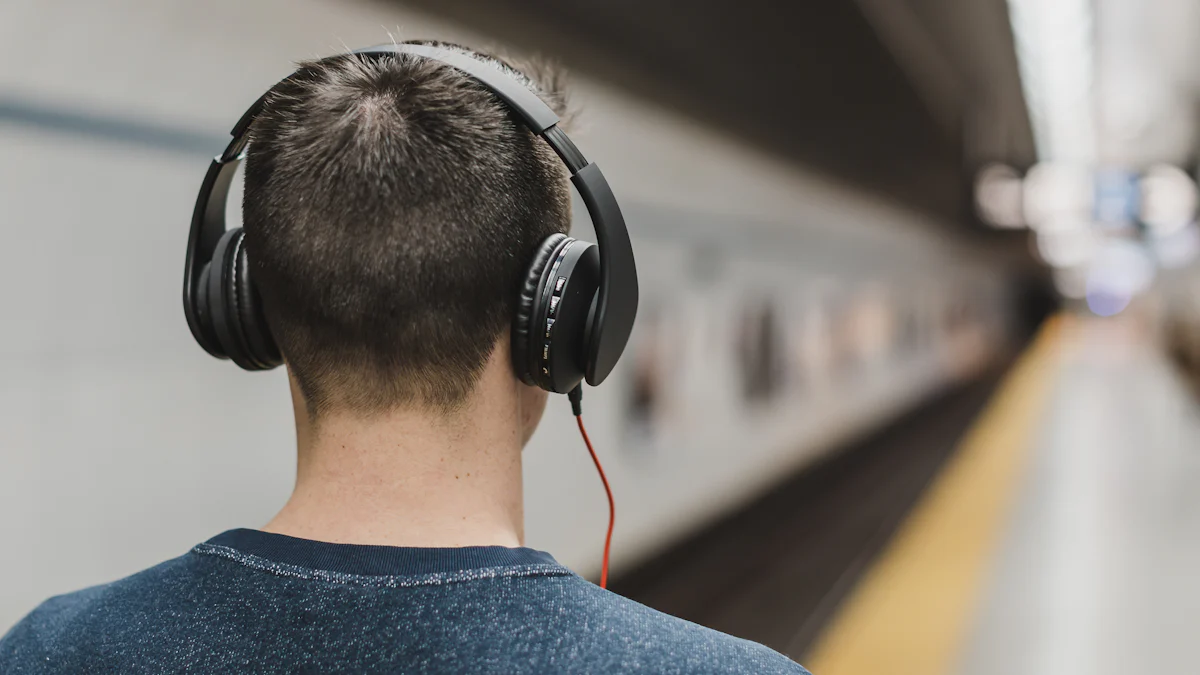Mastering Noise Control with Headsets in Open Offices

Open offices can be a productivity nightmare. Noise constantly surrounds you, making it hard to concentrate. Studies show that office workers are up to 66% less productive in open-plan spaces. Sound privacy ranks as the top frustration among employees. This is where Haiken comes in. Imagine having a personal bubble of silence. A headset with noise-cancelling microphone designed for clear calls in open offices can transform your workday. It blocks distractions and lets you focus. You’ll notice an immediate boost in productivity and job satisfaction. Haiken headsets offer this relief, turning chaos into calm.
Understanding Noise-Cancelling Technology

In the bustling environment of open offices, understanding how noise-cancelling technology works can be a game-changer. This technology helps you create a peaceful workspace amidst the chaos of cubicle noise. Let's dive into the mechanics of noise-cancelling headsets and how they can enhance your productivity.
How Noise-Cancelling Works
Noise-cancelling headsets use two primary methods to reduce unwanted sounds: active noise canceling and passive noise isolation.
Active Noise Cancellation
Active noise canceling (ANC) is a fascinating process. It involves tiny microphones on your headset that pick up external sounds. The headset then generates an anti-noise signal to counteract these sounds. This process effectively reduces consistent noises like the hum of an air conditioner or the chatter in a cubicle. ANC is particularly effective for steady, low-to-medium frequency sounds, making it ideal for open office environments.
Passive Noise Isolation
Passive noise isolation, on the other hand, relies on the physical design of the headset. The snug fit and materials used in the ear cups block out external noise. This method doesn't require any electronic components. It's like having a mini acoustic barrier around your ears. While it doesn't eliminate noise entirely, it significantly reduces background noise, allowing you to focus better.
The Science Behind Noise Reduction
The science behind noise reduction is both simple and complex. It involves understanding sound waves and the technology used in microphones and speakers.
Sound Waves and Frequency
Sound travels in waves, and each wave has a frequency. Noise-cancelling technology targets these frequencies. By emitting sound waves that are the exact opposite of the incoming noise, the headset cancels out the sound. This process is known as destructive interference. It's like having a personal cubicle noise reduction strategy right on your head.
Microphone and Speaker Technology
The microphones in noise-cancelling headsets play a crucial role. They continuously monitor the ambient noise around you. The speakers then produce the anti-noise signal. This seamless interaction between microphones and speakers creates a quieter environment, even in the noisiest cubicles. The result? You experience less cubicle noise and more focus.
By understanding these technologies, you can make informed decisions about which headsets will best suit your needs. Whether you're dealing with cubicle noise or looking for effective noise reduction strategies, noise-cancelling headsets offer a practical solution. They transform your open office into a more productive and peaceful space.
Benefits of Using Headsets in Open Offices

In open offices, noise can be a major hurdle. It disrupts your focus and makes it hard to concentrate. But with the right headsets, you can transform your workspace into a haven of productivity. Let's explore how these devices can enhance your work environment.
Enhanced Focus and Concentration
Blocking Out Distractions
Imagine trying to work while surrounded by constant chatter and ringing phones. It's tough, right? Headsets equipped with noise-canceling technology help you block out these distractions. They create a barrier between you and the chaos, allowing you to focus on your tasks. By reducing background noise, you can concentrate better and get more done.
Creating a Personal Sound Environment
Headsets do more than just block noise. They let you create a personal sound environment. You can listen to calming music or ambient sounds that help you stay focused. This personal bubble of sound keeps you in the zone, making it easier to tackle your to-do list. Implement acoustic wall panels alongside your headset for even greater noise reduction.
Improved Communication and Collaboration
Clearer Calls and Meetings
In open offices, clear communication is crucial. Headsets with a noise-canceling microphone ensure your voice comes through loud and clear during calls and meetings. No more shouting over the din or asking colleagues to repeat themselves. You can communicate effectively, even in a bustling office.
Reduced Miscommunication
Miscommunication can lead to mistakes and frustration. By using headsets, you minimize the risk of misunderstandings. Clear audio means you hear every word, reducing the chance of errors. This clarity fosters better collaboration and smoother interactions with your team.
Headsets are a game-changer in open offices. They help you manage noise, improve focus, and enhance communication. When combined with other solutions like acoustic wall panels or a Dezibel Wall, they create an optimal work environment. So, consider investing in a quality headset to boost your productivity and well-being.
Comparing Different Headset Models and Features
When choosing a headset for your open office, you want to consider several key features. These features can make a big difference in how well the headset meets your needs and enhances your work environment.
Key Features to Consider
Battery Life and Charging
Battery life is crucial when you spend long hours in an open office. You don't want your headset dying in the middle of an important call. Look for models that offer extended battery life. Some headsets provide up to 30 hours of use on a single charge. Quick charging capabilities can also be a lifesaver. A short charge during lunch can give you several more hours of use.
Comfort and Fit
Comfort is another essential factor. You’ll wear these headsets for hours, so they need to fit well. Look for headsets with adjustable bands and cushioned ear cups. Materials like foamed urethane can provide a snug fit without causing discomfort. A lightweight design ensures you barely notice you're wearing them, allowing you to focus on your tasks without distraction.
Popular Models on the Market
Let's explore two popular models that stand out in the market for their features and performance.
Sony WH-1000XM4 Overview
The Sony WH-1000XM4 headphones are a top choice for many employees in open offices. They offer advanced noise cancellation, which helps reduce noise effectively. With the HD Noise Cancelling Processor QN1 and dual noise sensor, you can listen without distractions. These headphones support High-Resolution Audio, providing exceptional sound quality. The WH-1000XM4 also features smart listening that adjusts to your behavior and location. Comfort is a priority with super-soft, pressure-relieving earpads. You can wear them all day without discomfort. Plus, they offer effortless operation, from controlling music to making hands-free calls.
Bose QuietComfort 35 II Overview
The Bose QuietComfort 35 II is another excellent option for open office environments. Known for its comfort and fit, this model provides a great acoustic experience. It features world-class noise cancellation, which helps reduce noise and distractions. The QuietComfort 35 II offers up to 20 hours of wireless playtime, ensuring you stay connected throughout the workday. Its lightweight design and plush ear cushions make it comfortable for extended use. The headset also integrates with voice assistants, allowing you to manage tasks hands-free.
Choosing the right headset involves considering these features and models. By focusing on battery life, comfort, and noise reduction capabilities, you can find a headset that transforms your open office into a more productive space. Follow Parterre Flooring for more tips on creating an optimal work environment with commercial LVT and acoustic solutions.
Tips for Selecting the Right Headset
Choosing the right headset for your open plan office can feel overwhelming. With so many options, how do you decide? Let's break it down into simple steps to help you make the best choice.
Assessing Your Specific Needs
Work Environment Considerations
First, think about your work environment. Is your open plan office noisy? If so, you might need a headset with strong noise-canceling features. ANC headsets from Plantronics offer excellent noise reduction, making them a popular choice. Consider the layout of your office. If you move around a lot, a wireless option like the Earpiece Wireless DECT Headset could be ideal.
Personal Preferences
Next, consider your personal preferences. Do you prefer over-ear or in-ear designs? Some people find comfortable office headsets with cushioned ear cups more pleasant for long hours. Others might like the lightweight feel of an in-ear model. Think about what feels best for you. Also, consider the style and brand. Some people love the sleek design of Viget headsets, while others prefer the classic look of Voyager models.
Budget and Value for Money
Cost vs. Features
Budget plays a big role in your decision. You want to get the most bang for your buck. Compare the cost of different models with their features. For instance, the Voyager Focus offers great value with its advanced noise-canceling technology and long battery life. Check if the headset includes features like ANC levels or a noise-canceling DECT wireless headset. These can enhance your experience in an open plan office.
Long-term Investment
Think of your headset as a long-term investment. A higher upfront cost might save you money in the long run. Quality headsets last longer and often come with better warranties. Consider how often you'll use the headset. If it's daily, investing in a durable model makes sense. Brands like Viget and Voyager are known for their reliability and longevity.
Additional Strategies for Optimal Noise Control
In open offices, noise can be a constant challenge. While headsets with ANC technology provide significant relief, you can enhance your noise control strategy with additional tools and practices. Let's explore some complementary techniques that can help you create a quieter and more focused workspace.
Complementary Tools and Techniques
White Noise Machines
Adding white noise machines to your office can be a game-changer. These devices emit a consistent sound that masks disruptive noises, helping you maintain focus. By adding white noise, you can reduce the impact of sudden sounds like phone rings or conversations. This creates a more stable auditory environment, allowing you to concentrate better on your tasks.
Office Layout Adjustments
The layout of your office plays a crucial role in noise control. Strategic placement of furniture and sound-absorbing materials can significantly reduce noise levels. Consider using acoustic panels, wall panels, and soundproofing curtains to absorb sound effectively. Heavy curtains, bookshelves, and cabinets can also help block sound. By rearranging your space, you can create dedicated quiet spaces that enhance productivity.
Personal Habits and Practices
Scheduled Quiet Times
Implementing scheduled quiet times in your office can boost productivity. Designate specific periods during the day when everyone focuses on their tasks without interruptions. This practice encourages a culture of respect for concentration and helps reduce overall noise levels. By setting aside time for quiet work, you can improve focus and efficiency.
Mindfulness and Focus Techniques
Practicing mindfulness can help you deal with noise more effectively. Techniques like deep breathing and meditation can enhance your ability to concentrate amidst distractions. By incorporating these practices into your routine, you can create a personal bubble of calm, even in a bustling office. Mindfulness helps you stay centered and focused, making it easier to tackle your workload.
Incorporating these strategies into your noise control plan can transform your open office into a more productive environment. By using tools like white noise machines and acoustic panels, and adopting practices like scheduled quiet times and mindfulness, you can create a workspace that supports focus and well-being. Explore options from Parterre for commercial flooring and acoustic solutions to further enhance your office design. Remember, dealing with noise effectively requires a combination of tools and habits. Choose options that best suit your needs and create a harmonious work environment.
You've explored how mastering noise control in open offices can transform your work environment. This article highlighted the benefits of using Poly wireless headsets and acoustic solutions like acoustic pods. These tools help you focus, reduce stress, and improve communication. Try out recommended headsets and strategies to create a serene workspace. By investing in noise reduction, you enhance productivity and well-being. Whether you're in a Boulder office or elsewhere, these insights apply universally. Remember, the right tools and practices make a significant difference. Embrace these changes for a more productive December.
See Also
Unlocking Audio Visual Skills: A Comprehensive Guide
Selecting the Best: Human vs. Robot 360 Speakers
Perfecting Your Skills for Effective Hybrid Zoom Meetings
